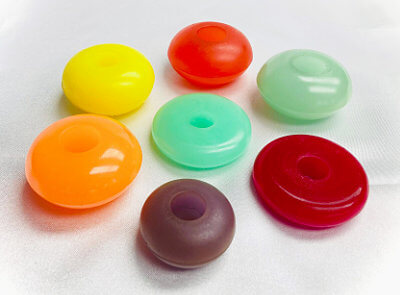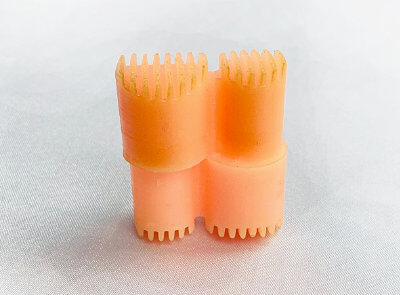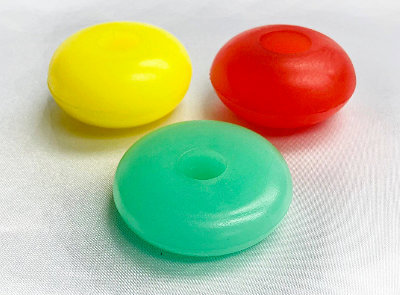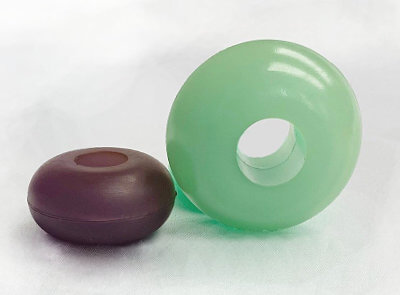The liquid polyurethane is poured into a heated mold and allowed to start the urethane reaction in the compression molding process. During the reaction, the mold is put under pressure to allow the sections of the part to react together and make one part from multiple sections when the reaction is completed.
The compression molding process is particularly useful where complex three-dimensional shapes are required, especially where large and variable cross-sections or heavier weights are needed. The technique allows for the production of parts similar to injection molding with the advantage of superior materials and lower upfront tooling costs.
Unlike injection molding, compression molding requires lower set-up costs and is very cost-efficient when producing smaller runs.
Why Should You Use a Compression Molding Process?
There are advantages in using the compression molding process.
- Variable cross-section widths
- Large cross-sections and part weights
- Reduced secondary processing
- Reduced excess flash
- Tooling costs low than injection molding
- Smaller production runs are possible
- Finer details are possible
Why This Type of Molding Process Might Not Be Right for Your Part
- Compared to open casting more expensive molds
- Looser tolerances
- Longer cycle times
- High amounts of scrap, which is not recyclable, add to part costs
One of the biggest advantages of the compression molding process is its ability to handle large cross-sections and part weights. This makes it ideal for creating complex three-dimensional shapes that require heavier materials. Unlike other molding processes, compression molding allows for superior materials to be used, resulting in high-quality parts with exceptional durability.
Another advantage of compression molding is the reduced need for secondary processing. This process can mold parts to near net shape, meaning less post-processing is required. This saves time and reduces costs associated with additional labor and equipment.
In addition, the compression molding process produces less excess flash compared to other molding techniques. Flash refers to the extra material that protrudes from the mold after the part has cooled. Since compression molding applies pressure to the mold during the reaction, it ensures that all sections of the part are properly fused together, minimizing the occurrence of flash.
Furthermore, one of the main reasons why many manufacturers choose compression molding over injection molding is lower tooling costs. The upfront investment required for compression molds is generally lower than that for injection molds. This makes it a more cost-effective option, especially for smaller production runs where high tooling costs can be a deterrent.
Additionally, the compression molding process allows for finer details to be achieved in the final parts. The pressure applied during the reaction ensures that the mold captures every intricate feature and detail accurately. This level of precision makes compression molding suitable for producing parts with complex designs or intricate textures.
Considerations When Choosing Compression Molding
While compression molding has numerous advantages, it may not be suitable for every part manufacturing process. Here are a few factors you should consider before deciding if this type of molding is right for your project:
Compared to open casting methods, compression molds tend to be more expensive due to their complexity and durability requirements. If cost is a major concern and you can achieve your desired results through simpler casting methods, exploring alternative molding techniques might be more economical.
Another consideration is tolerance. Compression molding typically results in looser tolerances compared to other molding processes. If your part requires extremely tight dimensional accuracy, you may need to opt for a different manufacturing method.
Keep in mind that compression molding generally has longer cycle times compared to other processes. The time required for the liquid polyurethane to react and fully cure can lengthen the overall production time. If you are working on a tight deadline or need a quick turnaround, compression molding might not be the best choice.
Lastly, it's worth noting that the compression molding process produces higher amounts of scrap compared to other methods, and this scrap is not recyclable. This can add to the overall cost of producing each part, so if minimizing waste and environmental impact is a priority for your project, consider alternative molding techniques.
Summary
Compression molding process offers numerous advantages for producing parts with complex shapes and large cross-sections. It provides superior materials, lower tooling costs, and the ability to achieve finer details. However, it may not be suitable for every project due to factors such as higher mold costs, looser tolerances, longer cycle times, and accumulation of non-recyclable scrap. Careful consideration of these factors will help you determine whether compression molding is the right choice for your specific part manufacturing needs.





